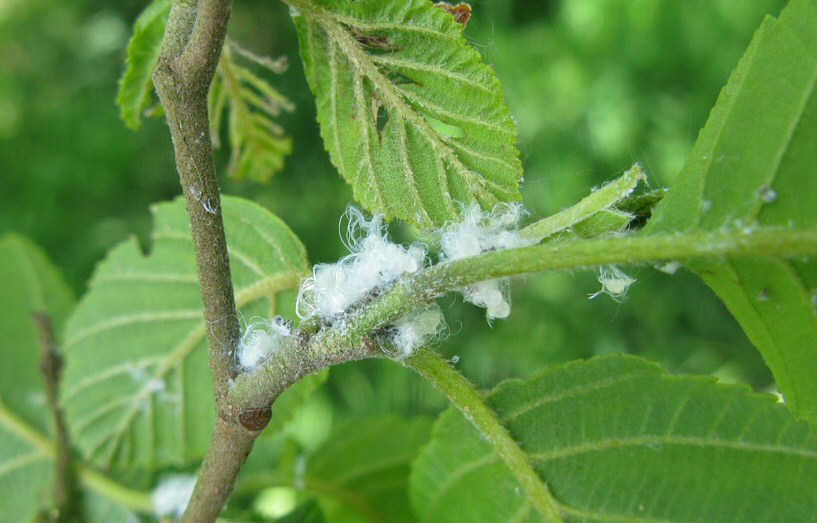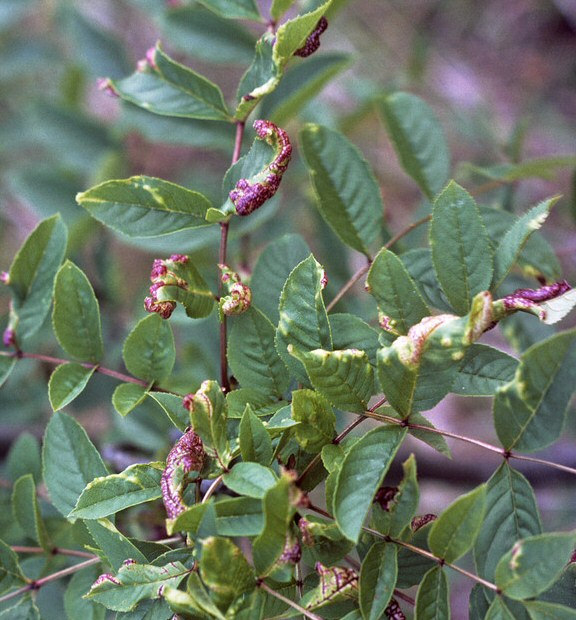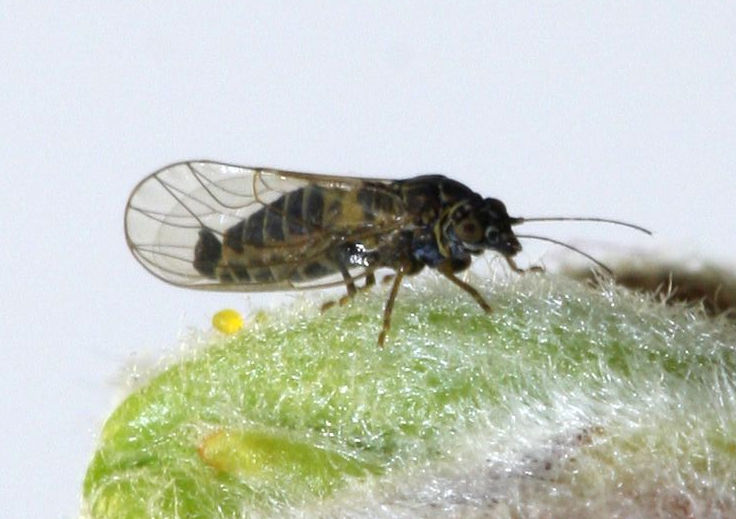- Home
- Garden Wildlife
- Insects
- Hemiptera
- Psyllids
Psyllids
Psyllids, also known as suckers or jumping plant lice, are sap-sucking insects in the Psylloidea of the order Hemiptera, sub-order Sternorrhyncha. Most are 2-3mm long and the adults resemble winged aphids but they hold their wings over their bodies at a more oblique angle. The nymphs are very distinctive as they are dorso-ventrally flattened and develop large wing pads as they approach maturity.
Species in Britain and Ireland
More than 80 species have been recorded in Britain and Ireland. Some can damage ornamental plants but the majority are found on wild plants. Common species found on garden plants are apple sucker, Cacopsylla mali, pear sucker, Cacopsylla pyricola, box sucker, Psylla buxi, bay sucker, Lauritrioza alacris, Pittosporum sucker, Trioza vitreoradiata, Elaeagnus sucker, Cacopsylla fulguralis, and eucalyptus sucker, Ctenarytaina eucalypti.


Cacopsylla picta Larvae of citrus psyllids showing flattened bodies
(Vector of apple proliferation disease in Europe)
Biology
As one of their common names imply, psyllids are very skilled jumpers to avoid predators, often launching into a very fast spinning trajectory.
Some psyllids cause growth abnormalities, known as galls, on their host plants. Bay sucker causes leaf margins to curl over and thicken, box sucker stunts shoot extension and causes cabbage-like clusters of leaves at the shoot tips, Pittosporum sucker causes young foliage to have a lumpy appearance. These growth abnormalities develop in response to chemicals secreted into the host plant by psyllid nymphs.
Other psyllids, such as apple sucker, pear sucker and eucalyptus sucker, feed openly on the young foliage and blossom without causing galls. Psyllid nymphs sometimes produce a fluffy white waxy secretion from their bodies. Plants that are heavily infested with psyllids often become sticky due to the sugary excrement, known as honeydew, that these insects produce. Fungal (sooty) moulds, often greyish green or black in colour, may develop on foliage coated with psyllid honeydew.

.jpg)
Ash sucker Psyllopsis fraxini galls Alder sucker Psylla alni nymphs showing fluffy wax secretion
Life cycle
Psyllids overwinter as eggs laid on the host plant or as adult insects in sheltered places. The nymphs develop during the spring on the young foliage or flower buds of their host plants. The immature nymphs have a very flat appearance, with wing pads that enlarge each time the nymphs shed their skin. For species with one generation a year, adults develop from May onwards.
Role of psyllids in gardens
Some psyllids can damage cultivated plants. Heavy infestations of apple sucker can kill the blossom, resulting in no fruit. Other psyllids spoil the appearance of plants by causing galled foliage and/or making the new growth sticky with their excrement.
In 2010 a psyllid, Aphalara itadori, which originates from Japan, was released in Britain in an attempt to control the highly invasive plant known as Japanese knotweed. The psyllid could stunt the growth of Japanese knotweed and prevent it from out-competing native plants and causing major structural damage to properties. The original populations released did not fare well in damp British conditions, but a new population identified in may be more successful.
Other sources of information
Website
Website of British Bugs
Website of the Japanese Knotweed Alliance
Books
Hodkinson, I. D. & White, I.M. (1979) Handbooks for the Identification of British Insects Vol 2 part 5a. Homoptera Psylloidea Royal Entomological Society – out of print but available as a free download here
Page drafted by Andrew Halstead, reviewed by Andrew Salisbury, edited by Steve Head
Psyllids
Psyllids, also known as suckers or jumping plant lice, are sap-sucking insects in the Psylloidea of the order Hemiptera, sub-order Sternorrhyncha. Most are 2-3mm long and the adults resemble winged aphids but they hold their wings over their bodies at a more oblique angle. The nymphs are very distinctive as they are dorso-ventrally flattened and develop large wing pads as they approach maturity.
Species in Britain and Ireland
More than 80 species have been recorded in Britain and Ireland. Some can damage ornamental plants but the majority are found on wild plants. Common species found on garden plants are apple sucker, Cacopsylla mali, pear sucker, Cacopsylla pyricola, box sucker, Psylla buxi, bay sucker, Lauritrioza alacris, Pittosporum sucker, Trioza vitreoradiata, Elaeagnus sucker, Cacopsylla fulguralis, and eucalyptus sucker, Ctenarytaina eucalypti.
.jpg)

Cacopsylla picta Nymphs of citrus psyllids (Vector of apple proliferation disease in Europe) showing flattened bodies
Biology
As one of their common names imply, psyllids are very skilled jumpers to avoid predators, often launching into a very fast spinning trajectory.
Some psyllids cause growth abnormalities, known as galls, on their host plants. Bay sucker causes leaf margins to curl over and thicken, box sucker stunts shoot extension and causes cabbage-like clusters of leaves at the shoot tips, Pittosporum sucker causes young foliage to have a lumpy appearance. These growth abnormalities develop in response to chemicals secreted into the host plant by psyllid nymphs.
Other psyllids, such as apple sucker, pear sucker and eucalyptus sucker, feed openly on the young foliage and blossom without causing galls. Psyllid nymphs sometimes produce a fluffy white waxy secretion from their bodies. Plants that are heavily infested with psyllids often become sticky due to the sugary excrement, known as honeydew, that these insects produce. Fungal (sooty) moulds, often greyish green or black in colour, may develop on foliage coated with psyllid honeydew.


Ash sucker Psyllopsis fraxini galls Alder sucker Psylla alni nymphs showing fluffy wax secretion
Life cycle
Psyllids overwinter as eggs laid on the host plant or as adult insects in sheltered places. The nymphs develop during the spring on the young foliage or flower buds of their host plants. The immature nymphs have a very flat appearance, with wing pads that enlarge each time the nymphs shed their skin. For species with one generation a year, adults develop from May onwards.
Role of psyllids in gardens
Some psyllids can damage cultivated plants. Heavy infestations of apple sucker can kill the blossom, resulting in no fruit. Other psyllids spoil the appearance of plants by causing galled foliage and/or making the new growth sticky with their excrement.
In 2010 a psyllid, Aphalara itadori, which originates from Japan, was released in Britain in an attempt to control the highly invasive plant known as Japanese knotweed. The psyllid could stunt the growth of Japanese knotweed and prevent it from out-competing native plants and causing major structural damage to properties. The original populations released did not fare well in damp British conditions, but a new population identified in may be more successful.
Other sources of information
Website
Website of British Bugs
Website of the Japanese Knotweed Alliance
Books
Hodkinson, I. D. & White, I.M. (1979) Handbooks for the Identification of British Insects Vol 2 part 5a. Homoptera Psylloidea Royal Entomological Society – out of print but available as a free download here
Page drafted by Andrew Halstead, reviewed by Andrew Salisbury, edited by Steve Head












